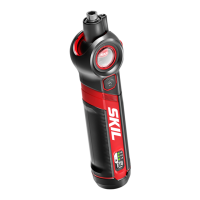10
OPERATING INSTRUCTIONS
WARNING
To reduce the risk of re, personal injury, and product
damage due to a short circuit, never immerse your tool
and charger in uid or allow a uid to ow inside them.
Corrosive or
conductive fluids, such as seawater, certain industrial chemicals, and bleach, or
bleach-containing products, etc., can cause a short circuit.
WARNING
If any parts are damaged or missing, do not operate this
product until the parts are replaced.
Use of this product
with damaged or missing parts could result in serious personal injury.
Intended Use
This tool is intended for driving or removing screws in wood, metal, plastic, and
other materials.
Charging the Tool (Fig. 2)
This screwdriver features an integrated battery.
NOTE:
Fully charge the tool before using it for the first use. The optimal charge is
achieved after 3 hours.
WARNING
The screwdriver is only to be charged with a certied USB
power supply or power source (5V, max. 1A). Never
charge the tool with any power supply or power source that is not certied.
Failure to obey this warning could cause battery damage and serious personal
injury.
1. Insert the USB-A connector of the USB-C charging cable into the USB power
supply (not included).
2. Insert the other connector of the USB-C charging cable into the charging port
of the tool, make sure that they are properly connected.
3. Plug the power supply into a standard power outlet. The battery/torque
indicators will flash to indicate the tool charging status:
Battery/Torque Indicator Tool Charging Status
3 LEDs flash alternately Battery capacity is below 30%
1 LED on, 2 LEDs flash alternately Battery capacity is within 30% – 60%
2 LED on, 1 LED flashes Battery capacity is above 60%
3 LEDS on Battery is fully charged
4. When charging is complete, the three battery/torque indicators will glow solid
green. Disconnect the USB-C charging cable from the tool.
NOTE:
The tool will not operate during charging.
NOTE:
It is normal for the tool to become warm during charging.
NOTE:
Do not charge the tool in extremely hot or cold conditions. Charging is
best achieved at normal room temperature.

